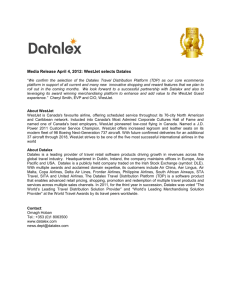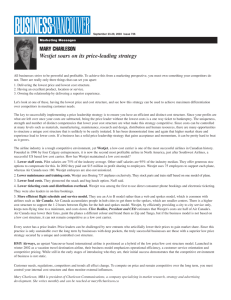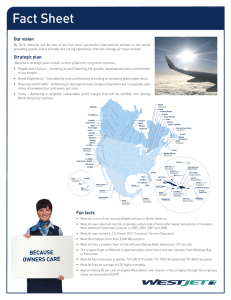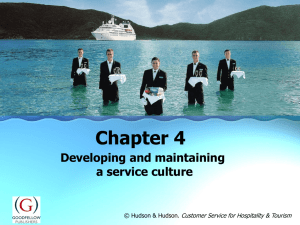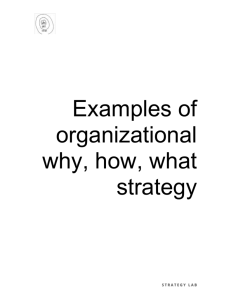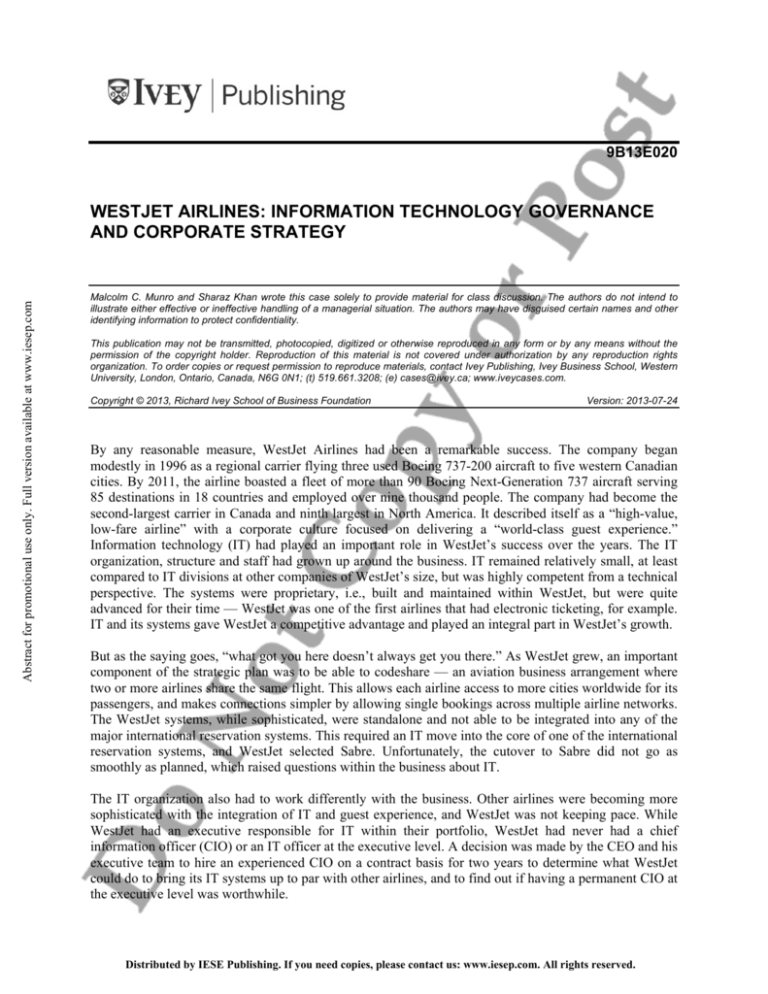
9B13E020
Abstract for promotional use only. Full version available at www.iesep.com
WESTJET AIRLINES: INFORMATION TECHNOLOGY GOVERNANCE
AND CORPORATE STRATEGY
Malcolm C. Munro and Sharaz Khan wrote this case solely to provide material for class discussion. The authors do not intend to
illustrate either effective or ineffective handling of a managerial situation. The authors may have disguised certain names and other
identifying information to protect confidentiality.
This publication may not be transmitted, photocopied, digitized or otherwise reproduced in any form or by any means without the
permission of the copyright holder. Reproduction of this material is not covered under authorization by any reproduction rights
organization. To order copies or request permission to reproduce materials, contact Ivey Publishing, Ivey Business School, Western
University, London, Ontario, Canada, N6G 0N1; (t) 519.661.3208; (e) cases@ivey.ca; www.iveycases.com.
Copyright © 2013, Richard Ivey School of Business Foundation
Version: 2013-07-24
By any reasonable measure, WestJet Airlines had been a remarkable success. The company began
modestly in 1996 as a regional carrier flying three used Boeing 737-200 aircraft to five western Canadian
cities. By 2011, the airline boasted a fleet of more than 90 Boeing Next-Generation 737 aircraft serving
85 destinations in 18 countries and employed over nine thousand people. The company had become the
second-largest carrier in Canada and ninth largest in North America. It described itself as a “high-value,
low-fare airline” with a corporate culture focused on delivering a “world-class guest experience.”
Information technology (IT) had played an important role in WestJet’s success over the years. The IT
organization, structure and staff had grown up around the business. IT remained relatively small, at least
compared to IT divisions at other companies of WestJet’s size, but was highly competent from a technical
perspective. The systems were proprietary, i.e., built and maintained within WestJet, but were quite
advanced for their time — WestJet was one of the first airlines that had electronic ticketing, for example.
IT and its systems gave WestJet a competitive advantage and played an integral part in WestJet’s growth.
But as the saying goes, “what got you here doesn’t always get you there.” As WestJet grew, an important
component of the strategic plan was to be able to codeshare — an aviation business arrangement where
two or more airlines share the same flight. This allows each airline access to more cities worldwide for its
passengers, and makes connections simpler by allowing single bookings across multiple airline networks.
The WestJet systems, while sophisticated, were standalone and not able to be integrated into any of the
major international reservation systems. This required an IT move into the core of one of the international
reservation systems, and WestJet selected Sabre. Unfortunately, the cutover to Sabre did not go as
smoothly as planned, which raised questions within the business about IT.
The IT organization also had to work differently with the business. Other airlines were becoming more
sophisticated with the integration of IT and guest experience, and WestJet was not keeping pace. While
WestJet had an executive responsible for IT within their portfolio, WestJet had never had a chief
information officer (CIO) or an IT officer at the executive level. A decision was made by the CEO and his
executive team to hire an experienced CIO on a contract basis for two years to determine what WestJet
could do to bring its IT systems up to par with other airlines, and to find out if having a permanent CIO at
the executive level was worthwhile.
Distributed by IESE Publishing. If you need copies, please contact us: www.iesep.com. All rights reserved.
Page 2
9B13E020
Abstract for promotional use only. Full version available at www.iesep.com
Cheryl Smith was contacted in early 2011. Following meetings with the WestJet CEO and the other
senior executives, Smith was appointed as executive vice-president and CIO in April 2011. Smith saw
WestJet as “exactly what I was looking for — a company that wanted to use IT to help it get to the next
level.” WestJet’s corporate strategy was heavily dependent on the ability of IT to deliver innovative guest
products and services, as well as solid operational support; IT was core to WestJet achieving its ambitions
and future corporate growth.
Smith immediately saw significant opportunities in the IT governance model at WestJet. Her first course
of action was to restructure the IT organization, align IT with corporate goals, overhaul IT planning and
budgeting and, in general, make IT more responsive to business needs. Overall, she proposed a major
transformation of IT along with aggressive solutions to pressing operational issues. But many of the IT
staff, some of whom had been with WestJet from the beginning, had reservations about Smith’s ideas.
Smith realized that selling a new vision for IT governance to both her executive team peers and IT staff
could be a major challenge. She would need a lot more than clever charts, graphs and diagrams. But
Smith knew that change in the governance model was a mandatory first step if IT was to become a strong
partner to the business and help it move to the next level, and she would need to move quickly.
THE WESTJET STORY
The headquarters and main hub for WestJet Airlines Ltd. was located at the Calgary International Airport
in Calgary, Canada. WestJet had been founded in 1996 by pilot/entrepreneur Clive Beddoe and three
business partners, who fashioned their business model as a low-cost carrier after one pioneered by
Southwest Airlines in the United States. Initial markets served included Calgary, Edmonton, Vancouver,
Kelowna and Winnipeg — all western Canadian cities, which gave the carrier its name. Flights to three
other cities in western Canada were added before the end of the year. By 1999, WestJet had expanded its
network to serve twelve western Canadian destinations.
Major growth beyond western Canada came quickly. In the years 2000 through 2004, WestJet added over
a dozen destinations in western and eastern Canada, including the major centres of Toronto, Montréal and
Halifax, thereby enabling the company to exploit the lucrative Toronto-Montréal-Ottawa triangle. The
WestJet network now spanned Canada coast to coast and the airline had begun replacing its fleet with
new Boeing Next-Generation 737 aircraft.
In the years 2004-2005, dramatic expansion occurred with WestJet adding flights to a number of major
U.S. destinations including San Francisco, Los Angeles, San Diego, Phoenix, New York City, Las Vegas
and Honolulu. A major milestone occurred in 2006 when WestJet began scheduled service to Nassau,
Bahamas — a key moment in the company’s long-term destination strategy. In 2009, WestJet adopted
Sabre, the international airline reservation system, enabling it to establish codeshare and interline
agreements with over 30 other airlines to draw new global traffic into its network — a move that
generated tens of millions of dollars in additional revenue from the codeshare partners within a couple of
years. Included in the agreements were such prominent carriers as American Airlines, Delta, United,
British Airways, Air France, KLM, Qantas, Air New Zealand and Air China. By 2011, having added
another 18 international destinations, WestJet was serving 81 destinations in North America, the
Caribbean and Mexico.
Growth in another form occurred in 2003 when WestJet partnered with Air Transat, which specialized in
providing charter flights from Canadian cities to Europe in the summer and southern destinations in the
winter. Under their agreement, WestJet crews and aircraft flew Air Transat passengers mainly to Mexican
Distributed by IESE Publishing. If you need copies, please contact us: www.iesep.com. All rights reserved.
Page 3
9B13E020
Abstract for promotional use only. Full version available at www.iesep.com
and Caribbean destinations. Building on this experience, WestJet launched WestJet Vacations in 2006,
which offered affordable and flexible flight and vacation packages.
Paralleling its growth in operations, WestJet became known as adept at growing a strong corporate
culture. Through the years 2003 to 2011, WestJet garnered numerous awards including being named as
Canada’s second-most respected corporation (2003) and as having Canada’s most admired corporate
culture (five straight years commencing in 2005), inclusion in Canada’s Most Admired Corporate
Cultures Hall of Fame (2010), having the Best Flight Attendants (2011), and being one of only two
Canadian companies to receive the J.D. Powers and Associates 2011 Customer Service Champion award.
WestJet expressed its strong corporate culture and dedication to customer service with the employee
slogan “Because Owners Care,” which referred to the fact that about 86 per cent of eligible employees
participated in the employee share purchase plan.
A capstone event was the opening in 2009 of WestJet’s new six-story head office building next to its
existing hangar embedded deep among the runways of Calgary’s rapidly expanding international airport
(see Exhibit 1). The new building symbolized the company’s muscle, which had enabled it to shoulder its
way into the Canadian market, increasing WestJet’s domestic market share from seven per cent in 2000 to
38 per cent by 2009. This compared favourably with its major competitor, Air Canada, whose market
share dropped from 77 per cent to 55 per cent in the same timeframe. WestJet’s 2011 Annual Report
stated, “2011 marks the fifteenth time we have reported an annual profit in our 16-year history and we
expect this profitable trend to continue” (see Exhibit 2 for financial highlights).
In summary, the WestJet wizards had performed the air industry’s equivalent of transforming a mom-andpop corner store into a thriving international retailer in a decade and a half.
THE NEW CHIEF INFORMATION OFFICER
“When you have already achieved your career goals but have outstanding business experience and many
more years to contribute, what do you do?” This was the question facing Cheryl Smith in 2010. Smith had
begun her career by earning a Master in Public Administration degree at Pennsylvania State University in
1973 with a thesis on computing in public organizations. She pursued this interest with her first job at the
newly established House Information Systems (HIS) of the U.S. House of Representatives as a
programmer analyst and, eventually, manager. After seven years with HIS and with two children to raise,
Smith established her own consulting firm, Analinc Corp, working with a number of commercial, nonprofit and government clients. Her consultancy at this time focused on detailed database design, system
acceptance test plans and site/facilities planning.
In 1985, Smith began a five-year appointment as a Principal at Ernst & Young, the giant accounting and
professional services firm. Her responsibilities included large information systems planning, analysis,
design, development and implementation for a wide range of major organizations.
In 1990, Smith began her steady climb up the career/corporate ladder as she left Ernst & Young for the
position of management information systems director for Honeywell Federal Systems Inc. This was
followed in 1994 with her appointment as a business unit CIO with Bell Atlantic Corp. (now Verizon),
and in 1998 as senior vice-president and CIO of KeySpan Energy (now National Grid), a newly formed
New York-based energy company, which merged with several other energy companies during her tenure
to become one of the largest energy companies in the eastern United States.
Distributed by IESE Publishing. If you need copies, please contact us: www.iesep.com. All rights reserved.
Page 4
9B13E020
Abstract for promotional use only. Full version available at www.iesep.com
Smith then achieved her long-term career goal of becoming a CIO of a Fortune 50 company when she
was appointed executive vice-president and CIO of McKesson Corp in September 2002. McKesson was
one of the world’s leading pharmaceutical and healthcare technology service companies. Smith was
responsible for McKesson’s IT worldwide, including its company-wide technology strategy and direction,
as well as day-to-day operations. She managed an annual budget of $400 million and led 1,500 IT
employees.
By 2006, Smith was ready for a new challenge and a different career experience, this time as a CEO. She
found this challenge as CEO of utility.net, a privately held company established to leverage a set of nextgeneration broadband over power lines (BPL) patents into large electricity companies. Deploying BPL
technology on energy company grids would enable utility.net to offer high-speed Internet access, voice
over Internet Protocol and other broadband services inexpensively to homes and businesses in rural areas.
Unfortunately, the company was unsuccessful in obtaining a large ($50 million) third round of financing
during a time of considerable contraction in the venture capital and credit markets, which forced a
graceful shutdown of the company in 2009.
In 2010, Smith reflected on her career as a senior IT executive with experience as a CEO and CIO in
industry sectors as diverse as energy, healthcare, telecommunications, manufacturing and federal agency
services. She realized she had derived her greatest satisfaction from bringing significant tangible value to
organizations through the innovative deployment of IT. For Smith, the most exciting opportunities lay
with companies wanting to use IT as a game-changer — companies for whom IT was integral to their
corporate strategy and future growth. She saw herself as a “change agent” and felt confident in her ability
to effect critical business transformations using IT.
These factors ultimately led her to conclude that her niche in the IT marketplace now was as a “contract
CIO,” someone who could parachute into an organization and bring immediate value, but for whom a
limited-term contract was acceptable. Such an arrangement had the advantage of freeing prospective
employers from the potential risk of a permanent arrangement with a new employee.
In collaboration with a few colleagues, Smith listed her availability in late 2010 on her own website
(www.smithandassociates.us.com), indicating her interest in working for a company in the $3 billion-$5
billion revenue range that was serious about “having IT be a key player in helping to take the company to
the next level.” She was contacted by WestJet early in 2011 and accepted the invitation to meet the CEO,
Gregg Saretsky, in Toronto. This was soon followed by a group meeting with her future senior
management peers and individual conversations with several people in IT. WestJet and Smith seemed to
be a perfect match. Everything went smoothly and she accepted a two-year appointment that commenced
on April 25, 2011, as executive vice-president and CIO.
THE WESTJET IT SITUATION
Two years before Smith arrived, WestJet decided to move to the Sabre reservation system — the
computer-based reservation system widely used by airlines and travel agencies throughout the world. The
cutover to Sabre in October 2009 was a difficult transition into the world of shared airline systems. It
made WestJet’s leadership sensitive to the company’s dependence on technology and its IT organization
for operational support and strategic growth.
Having the IT staff and their business counterparts work hand-in-hand for the first 15 exciting growth
years meant that those on both sides who were now WestJet executives were unable to describe or specify
Distributed by IESE Publishing. If you need copies, please contact us: www.iesep.com. All rights reserved.

